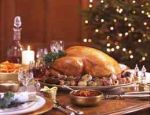 |
All about turkey >Origin & Traditions
Fowl of the gallinaceous order. Originally from North America, the turkey was introduced into Europe by the Spanish. Later, Christopher Columbus, believing he had discovered the Indies, named the fowl "polletz d'Inde" (Indian chicken), which in French became shortened to "dinde". Similarly, in English the word "turkey" came into being because of confusion in the 16th century between species of fowl from America and others from Africa, which at the time were called "Turks."
In 1518, Jesuit missionaries accompanying Cortez to Mexico grew so fond of the birds that they brought them back to Spain where they became so adept at raising them that, for a time, turkeys were called by the same name: Jesuits!
According to tradition, the first turkey eaten in France was served at the wedding of Charles IX in 1570. This noble bird was so rare in that era that it was included in Louis XIV's menagerie at the chateau of Versailles.
Over the centuries, producers have crossed different varieties to obtain birds with more meat and with whiter plumage. Why white? Because coloured birds have pigments on their skin, and consumers prefer plump turkeys with a nice uniformly pink skin… though in France, you will find the Ardennes red variety and few black varieties from Le Gers in Gascony and from Normandy.
This large wildfowl was hunted by native North American tribes. The aboriginal women would cook them with corn, lima beans and tomatoes. The dish now known as "Brunswick stew" follows the same recipe served by the Cherokee, Powhatan and Chickahominy tribes to the Jamestown settlers.

Thanksgiving is a particularly English custom - in French Canada, particularly in Quebec, it is not a holiday that receives much attention. Instead, turkey is saved for the Christmas réveillon, and pumpkins for Halloween. In the United States, over 40 million turkeys are eaten each year over the November Thanksgiving weekend! The bird is usually stuffed and roasted whole, but recipes differ among regions. On the east coast, oyster stuffing is traditional, a throwback to colonial days when these molluscs were a cheap and plentiful staple of the daily diet. In the southern US, where corn is king, corn bread stuffing is the norm, while in the lake regions of Minnesota, following a tradition that goes back to the Winnebago and Chippewa tribes, turkeys are often stuffed with wild rice, the black grain that the native peoples esteemed as highly as gold.

Whether stuffed with chestnuts in Great Britain and France, with bread and sage in Quebec, with meat, tomatoes and berries in Greece, with walnuts in Portugal, or glazed with lemon juice or bourbon in the US, the turkey reigns over countless Christmas tables throughout Europe and America.

-

 Recipes
Recipes
-

 Products
Products
-

 Entertaining
Entertaining
-

 Chefs
Chefs
-

 Hints & Tips
Hints & Tips
-

 Glossaries
Glossaries








